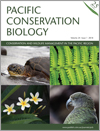
Pacific Conservation Biology
Volume 24 Number 1 2018
PC17010Herbicidal control of bridal creeper (Asparagus asparagoides) in an ecologically sensitive environment
Many terrestrial orchid populations in southern Australia are threatened by the noxious environmental weed Asparagus asparagoides. This paper describes a safe method of applying herbicides to control this weed in populations of the threatened terrestrial orchid Pterostylis arenicola. The technique of weed wiping is particularly suitable for use in areas of high conservation concern.
PC17027Predicting the occurrence of an endangered reptile based on habitat attributes
The endangered Blue Mountains water skink is restricted to highland peat swamps in eastern Australia. We show that Eulamprus leuraensis were found at sites with higher soil moisture, more burrows and live vegetation and a denser understorey. We developed a quick field detection method to assess the likely presence of the species, and mapped its known and predicted habitat using GIS.
PC17042Diets of native and introduced apex predators in Hawai'i
This paper describes diets and dietary overlap in four apex predators in Hawai‘i: pueo, barn owl, cat and mongoose, based on analysis of the contents of owl pellets and cat and mongoose scats, which were collected from eight different areas on five of the Main Hawaiian Islands.
PC17046Conservation value of koa (Acacia koa) reforestation areas on Hawaii Island
Koa (Acacia koa) reforestation areas (KRAs) on Hawaii Island are structurally similar to nearby intact forests in some cases, though species composition differs. Koa reforestation areas may provide a conservation benefit by re-establishing forest structure on degraded pasture. Some KRAs harbour understorey species as well.
PC17039Coyote diet patterns in the Mojave Desert: implications for threatened desert tortoises
Coyote predation on threatened desert tortoises was examined near Barstow, California, during 2009–14. On the basis of analyses of coyote scats, predation on tortoises appeared to be primarily opportunistic and was little influenced by the availability of other food items.
PC17039 Abstract | PC17039 Full Text | PC17039PDF (661 KB) Open Access Article
PC17030Forest connectivity is important for sustaining Admiralty cuscus (Spilocuscus kraemeri) in traditional terrestrial no-take areas on Manus Island, Papua New Guinea
We investigated denning home range and movement patterns of 10 cuscus using radio-telemetry in and around a 21-ha forested tambu area over a 28-day period. Home-range size was highly variable and log-normally distributed (mean = 2.9 ha). We conclude that similar sized tambu areas are too small to be self-sustaining.
PC17034Quantifying trends and predictors of decline in eastern grey kangaroo (Macropus giganteus) populations in a rapidly urbanising landscape
Eastern grey kangaroo populations have declined in many areas of the South East Queensland bioregion of Australia, a region that has undergone high rates of urbanisation. Further declines can be anticipated and processes of urbanisation, including higher human population growth rates and smaller areas of natural habitat retained, were predictors of kangaroo decline.
PC17031Foraging behaviour of mulga birds in Western Australia. I. Use of resources and temporal effects
Mulga birds allocated foraging resources similarly to other bird communities, with species differing in foraging behaviours and substrates. Foraging behaviour and species assemblages were sensitive to rainfall and associated changes in the abundance and type of prey available, with nomadic species departing as rainfall decreased.
PC17032Foraging behaviour of mulga birds in Western Australia. II. Community structure and conservation
Although mulga is floristically and structurally diverse, the composition of the avifauna is consistent. In years of high rainfall, nine foraging guilds were shared between mulga sites in Western Australia and the Northern Territory. However, guilds differed between locations in species assemblages, with species allocated to different guilds during years of low rainfall.
PC17038Are there conservation implications for kangaroos feeding on sea birds?
This research note documents an observation of a wild western grey kangaroo (Macropus fuliginosus) feeding on a dead silver gull (Chroicocephalus novaehollandiae). We consider why the kangaroo may be feeding on the dead gull and possible implications for conservation programs relying on poison meat baits to control introduced species.



